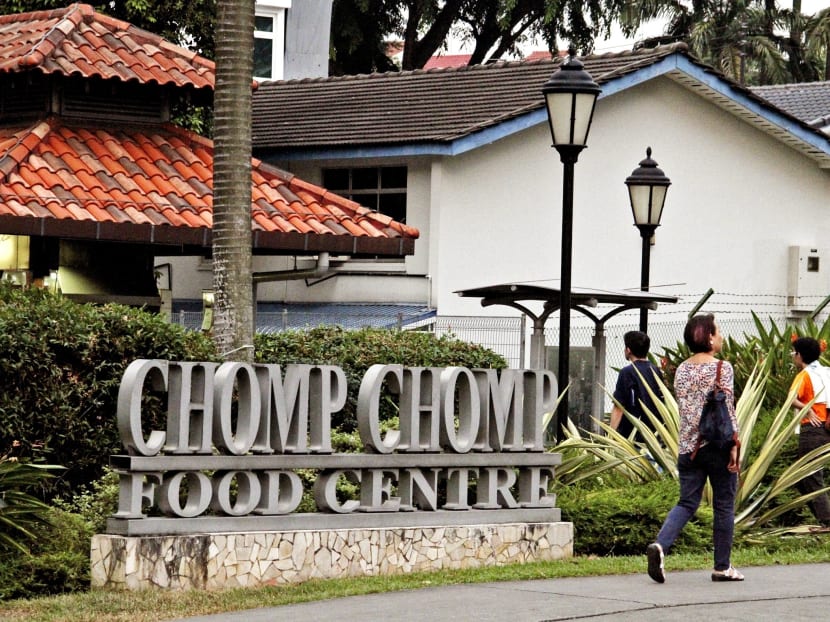Unique histories of 12 hawker centres to be studied for heritage project
SINGAPORE — Twelve hawker centres have been selected for a research project by the National Heritage Board (NHB) and the National Environment Agency, which could help pave the way for heritage corners and food trails, and give due recognition to the contribution of hawker centres to Singapore’s food heritage.

Chomp Chomp Food Centre and 11 other hawker centres islandwide have been selected for a research project by the National Heritage Board (NHB) and the National Environment Agency, which could form part of future planning for heritage corners, markers and food trails. TODAY file photo
SINGAPORE — Twelve hawker centres have been selected for a research project by the National Heritage Board (NHB) and the National Environment Agency, which could help pave the way for heritage corners and food trails, and give due recognition to the contribution of hawker centres to Singapore’s food heritage.
The hawker centres are: Tiong Bahru Market, Newton Food Centre, Chinatown Market, Maxwell Food Centre, Geylang Serai Market, Old Airport Road Food Centre, East Coast Lagoon, Tekka Market, People’s Park, Chomp Chomp, Changi Village Hawker Centre and Adam Road Food Centre.
Some food and heritage experts, however, have questioned the choices: Most on the list are touristy places while lesser-known hawker centres in the heartlands were excluded, they noted.
The NHB called a tender for interested companies to research and prepare a detailed report on 12 hawker centres. The tender closed last month.
In response to TODAY’s queries, a NHB spokesperson said the research will cover areas such as the historical and heritage value of these hawker centres, their key architectural features, as well as social and community significance to the estates they are in. “The findings will form the research for future plans for the 12 hawker centres, which could include heritage corners and markers as well as food trails,” added the spokesperson.
NHB assistant chief executive (policy and community) Alvin Tan added that the project is part of NHB’s ongoing efforts to document different aspects of Singapore’s cultural heritage.
Through the project, the board hopes to showcase the unique heritage of the hawker centres and “accord them due recognition as platforms for the preservation and transmission of Singapore’s food heritage”, he said.
President of civic group My Community Kwek Li Yong felt the initiative was a good one. Hawker centres serve as “third spaces” for community bonding, where people interact and create shared memories and experiences. “These research will allow us to understand our own food heritage and community heritage much better,” he said.
But he also noted that most of centres identified for research are tourist attractions, and said the research could be extended to neighbourhood hawker centres.
Food critic and Makansutra founder KF Seetoh observed that the 12 centres are in and around the city centre, and in the west. “Important food areas such as Hougang (for Teochew cuisine) and industrial areas such as Jurong are missing.”
For the study to have an impact, it should also address “people’s affinity to the food”, he said. “If the breadth of the research does not touch the heartstrings of Singaporeans ... then it will fall flat as food culture is very deeply rooted and does not centre around just hawker centres,” he added.
But Dr Leslie Tay of food blog ieatishootipost felt it was a good start, given that the histories of well-known hawker centres are little-known, especially to younger diners. “These are important things that need research ... they helped to feed a nation,” he said.
The authorities can add to the initial list after an assessment, added Dr Tay, who is part of a 14-member committee tasked by the Government to recommend ways to improve hawker centres and promote the trade.
Hawkers TODAY interviewed felt the key ingredient to keeping the culture alive is centred on one thing: Food.
Ms Peggy Hoo, 56, who helps out at a wonton noodle stall at Chomp Chomp, felt that as long as the hawkers continue to ply their trade, their heritage would not be lost.
They also pointed out that younger Singaporeans must be willing to pick up the trade, such as third-generation hawker Foo Sheng Hua, 33.
He took over Hai Yan BBQ Seafood at Newton Food Centre because he enjoyed interacting with customers and was keen on cooking. “But it’s a difficult job, who will want to do a job with such long hours?” asked Mr Foo. ADDITIONAL REPORTING BY ILIYAS JUANDA






